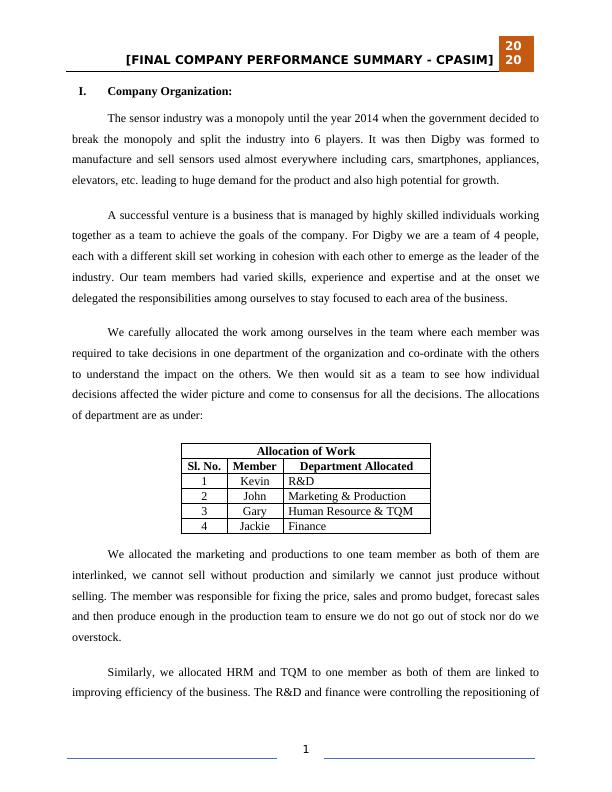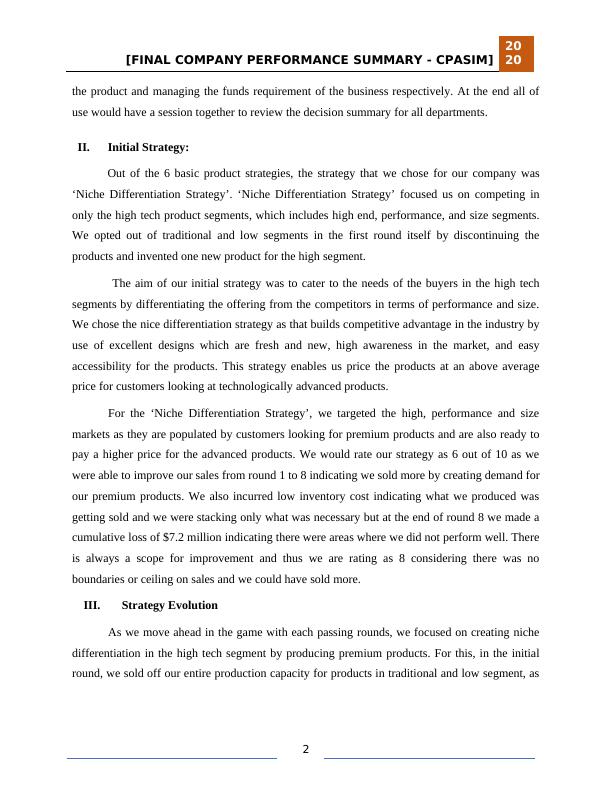Business Research Assignment | Case Study on Digby
Added on 2022-08-13
9 Pages2891 Words48 Views
[FINAL COMPANY PERFORMANCE SUMMARY - CPASIM]
20
20
Final Company Performance Summary
{Student/Group Name}
{Name of the university}
February 18, 2020
20
20
Final Company Performance Summary
{Student/Group Name}
{Name of the university}
February 18, 2020

[FINAL COMPANY PERFORMANCE SUMMARY - CPASIM]
20
20
I. Company Organization:
The sensor industry was a monopoly until the year 2014 when the government decided to
break the monopoly and split the industry into 6 players. It was then Digby was formed to
manufacture and sell sensors used almost everywhere including cars, smartphones, appliances,
elevators, etc. leading to huge demand for the product and also high potential for growth.
A successful venture is a business that is managed by highly skilled individuals working
together as a team to achieve the goals of the company. For Digby we are a team of 4 people,
each with a different skill set working in cohesion with each other to emerge as the leader of the
industry. Our team members had varied skills, experience and expertise and at the onset we
delegated the responsibilities among ourselves to stay focused to each area of the business.
We carefully allocated the work among ourselves in the team where each member was
required to take decisions in one department of the organization and co-ordinate with the others
to understand the impact on the others. We then would sit as a team to see how individual
decisions affected the wider picture and come to consensus for all the decisions. The allocations
of department are as under:
Allocation of Work
Sl. No. Member Department Allocated
1 Kevin R&D
2 John Marketing & Production
3 Gary Human Resource & TQM
4 Jackie Finance
We allocated the marketing and productions to one team member as both of them are
interlinked, we cannot sell without production and similarly we cannot just produce without
selling. The member was responsible for fixing the price, sales and promo budget, forecast sales
and then produce enough in the production team to ensure we do not go out of stock nor do we
overstock.
Similarly, we allocated HRM and TQM to one member as both of them are linked to
improving efficiency of the business. The R&D and finance were controlling the repositioning of
1
20
20
I. Company Organization:
The sensor industry was a monopoly until the year 2014 when the government decided to
break the monopoly and split the industry into 6 players. It was then Digby was formed to
manufacture and sell sensors used almost everywhere including cars, smartphones, appliances,
elevators, etc. leading to huge demand for the product and also high potential for growth.
A successful venture is a business that is managed by highly skilled individuals working
together as a team to achieve the goals of the company. For Digby we are a team of 4 people,
each with a different skill set working in cohesion with each other to emerge as the leader of the
industry. Our team members had varied skills, experience and expertise and at the onset we
delegated the responsibilities among ourselves to stay focused to each area of the business.
We carefully allocated the work among ourselves in the team where each member was
required to take decisions in one department of the organization and co-ordinate with the others
to understand the impact on the others. We then would sit as a team to see how individual
decisions affected the wider picture and come to consensus for all the decisions. The allocations
of department are as under:
Allocation of Work
Sl. No. Member Department Allocated
1 Kevin R&D
2 John Marketing & Production
3 Gary Human Resource & TQM
4 Jackie Finance
We allocated the marketing and productions to one team member as both of them are
interlinked, we cannot sell without production and similarly we cannot just produce without
selling. The member was responsible for fixing the price, sales and promo budget, forecast sales
and then produce enough in the production team to ensure we do not go out of stock nor do we
overstock.
Similarly, we allocated HRM and TQM to one member as both of them are linked to
improving efficiency of the business. The R&D and finance were controlling the repositioning of
1

[FINAL COMPANY PERFORMANCE SUMMARY - CPASIM]
20
20
the product and managing the funds requirement of the business respectively. At the end all of
use would have a session together to review the decision summary for all departments.
II. Initial Strategy:
Out of the 6 basic product strategies, the strategy that we chose for our company was
‘Niche Differentiation Strategy’. ‘Niche Differentiation Strategy’ focused us on competing in
only the high tech product segments, which includes high end, performance, and size segments.
We opted out of traditional and low segments in the first round itself by discontinuing the
products and invented one new product for the high segment.
The aim of our initial strategy was to cater to the needs of the buyers in the high tech
segments by differentiating the offering from the competitors in terms of performance and size.
We chose the nice differentiation strategy as that builds competitive advantage in the industry by
use of excellent designs which are fresh and new, high awareness in the market, and easy
accessibility for the products. This strategy enables us price the products at an above average
price for customers looking at technologically advanced products.
For the ‘Niche Differentiation Strategy’, we targeted the high, performance and size
markets as they are populated by customers looking for premium products and are also ready to
pay a higher price for the advanced products. We would rate our strategy as 6 out of 10 as we
were able to improve our sales from round 1 to 8 indicating we sold more by creating demand for
our premium products. We also incurred low inventory cost indicating what we produced was
getting sold and we were stacking only what was necessary but at the end of round 8 we made a
cumulative loss of $7.2 million indicating there were areas where we did not perform well. There
is always a scope for improvement and thus we are rating as 8 considering there was no
boundaries or ceiling on sales and we could have sold more.
III. Strategy Evolution
As we move ahead in the game with each passing rounds, we focused on creating niche
differentiation in the high tech segment by producing premium products. For this, in the initial
round, we sold off our entire production capacity for products in traditional and low segment, as
2
20
20
the product and managing the funds requirement of the business respectively. At the end all of
use would have a session together to review the decision summary for all departments.
II. Initial Strategy:
Out of the 6 basic product strategies, the strategy that we chose for our company was
‘Niche Differentiation Strategy’. ‘Niche Differentiation Strategy’ focused us on competing in
only the high tech product segments, which includes high end, performance, and size segments.
We opted out of traditional and low segments in the first round itself by discontinuing the
products and invented one new product for the high segment.
The aim of our initial strategy was to cater to the needs of the buyers in the high tech
segments by differentiating the offering from the competitors in terms of performance and size.
We chose the nice differentiation strategy as that builds competitive advantage in the industry by
use of excellent designs which are fresh and new, high awareness in the market, and easy
accessibility for the products. This strategy enables us price the products at an above average
price for customers looking at technologically advanced products.
For the ‘Niche Differentiation Strategy’, we targeted the high, performance and size
markets as they are populated by customers looking for premium products and are also ready to
pay a higher price for the advanced products. We would rate our strategy as 6 out of 10 as we
were able to improve our sales from round 1 to 8 indicating we sold more by creating demand for
our premium products. We also incurred low inventory cost indicating what we produced was
getting sold and we were stacking only what was necessary but at the end of round 8 we made a
cumulative loss of $7.2 million indicating there were areas where we did not perform well. There
is always a scope for improvement and thus we are rating as 8 considering there was no
boundaries or ceiling on sales and we could have sold more.
III. Strategy Evolution
As we move ahead in the game with each passing rounds, we focused on creating niche
differentiation in the high tech segment by producing premium products. For this, in the initial
round, we sold off our entire production capacity for products in traditional and low segment, as
2

End of preview
Want to access all the pages? Upload your documents or become a member.
Related Documents
Strategic Management Simulation - ULMS774lg...
|13
|2766
|27
